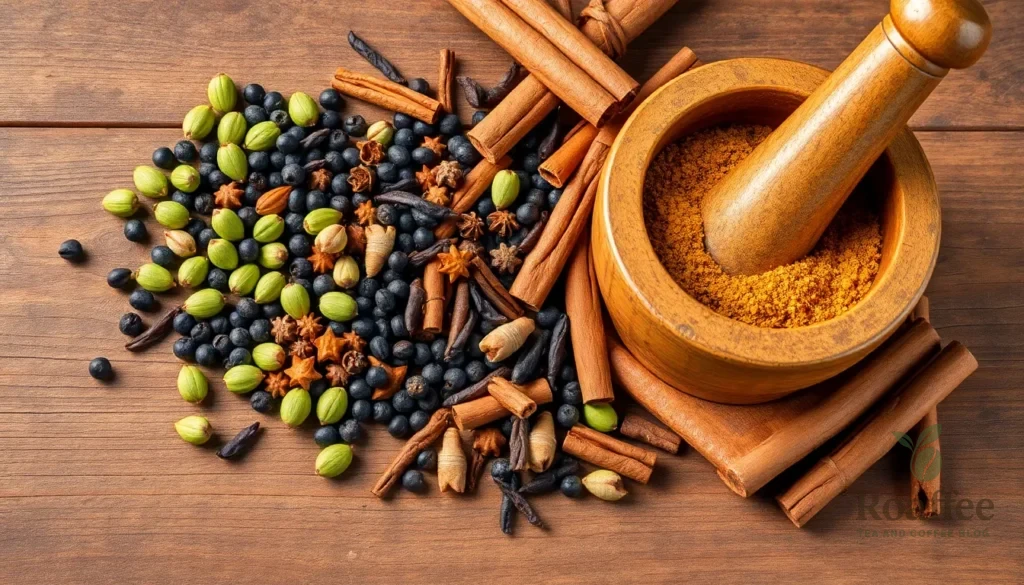Nothing beats the aromatic warmth of perfectly spiced tea, and tea masala powder is the secret ingredient that transforms ordinary chai into an extraordinary experience. This homemade spice blend combines traditional Indian spices like cardamom, cinnamon, cloves, and ginger to create a fragrant powder that’ll elevate every cup of tea you brew.
We’ve perfected this tea masala recipe through years of experimentation, balancing each spice to achieve that perfect harmony of warmth and flavor. Making your own masala powder means you control the ingredients and intensity – no more store-bought blends with artificial flavors or preservatives.
Once you start using this homemade tea masala powder, you’ll wonder how you ever lived without it. The convenience of having this aromatic blend ready in your pantry means you’re always just minutes away from a soul-warming cup of masala chai that rivals any tea shop.
Ingredients
Our homemade tea masala powder relies on carefully selected whole spices that create the perfect aromatic blend. These ingredients work together to deliver the authentic chai flavor we all crave.
Whole Spices
- 2 tablespoons green cardamom pods
- 1 tablespoon black peppercorns
- 6 whole cloves
- 2 cinnamon sticks (3-inch pieces)
- 1 tablespoon fennel seeds
- 1 teaspoon cumin seeds
- 1 whole nutmeg
- 1 tablespoon dried ginger pieces
- 1 star anise
- 1 bay leaf
Ground Spices (Optional)
- 1 teaspoon ground ginger powder
- 1/2 teaspoon ground black pepper
- 1/4 teaspoon ground nutmeg
Equipment Needed
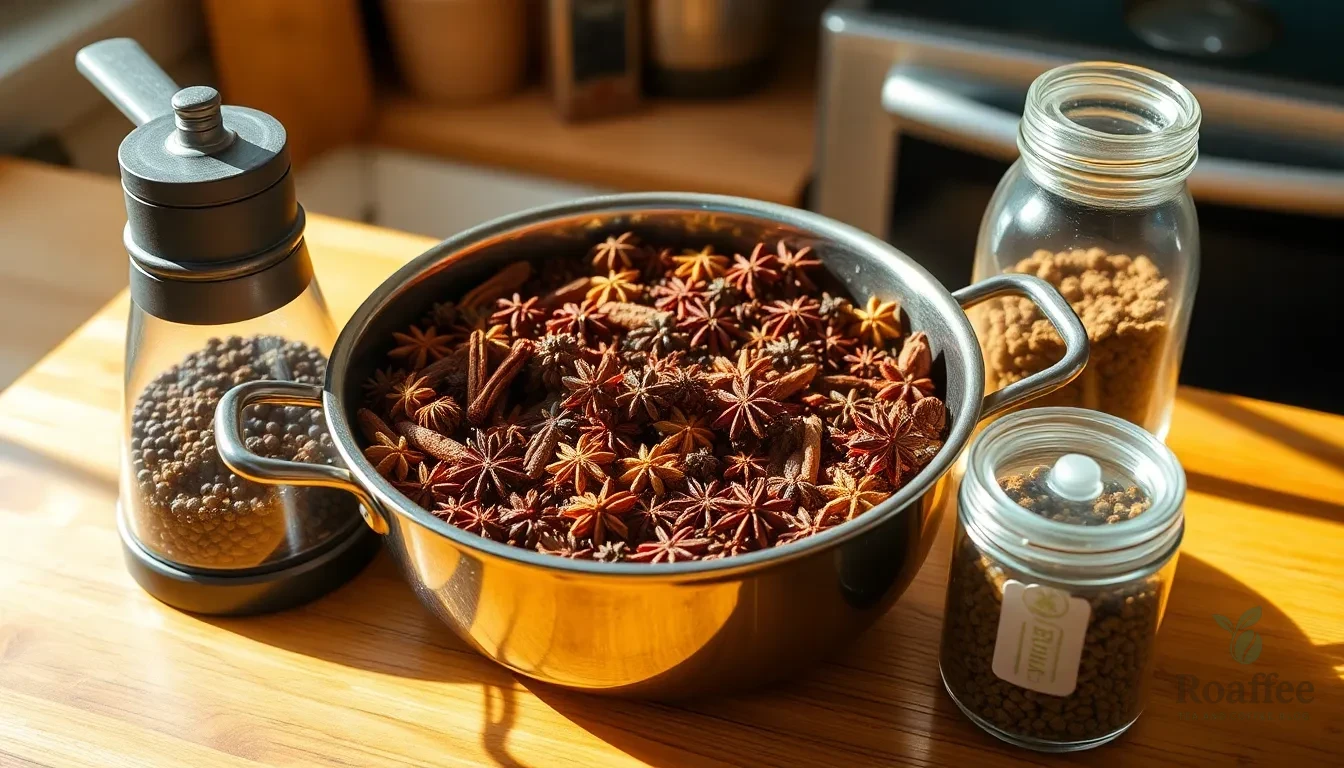
Creating our homemade tea masala powder requires exact tools to achieve the perfect aromatic blend. We recommend gathering these essential items before beginning the spice preparation process.
Heavy-bottomed pan or skillet serves as our primary tool for dry roasting the whole spices. This type of cookware distributes heat evenly and prevents burning while allowing us to achieve that perfect golden color and enhanced fragrance from our spices.
Spice grinder or blender transforms our roasted spices into the fine powder we need. We prefer using a dedicated spice grinder for the best results, though a high-powered blender works as an alternative option for grinding the cooled spices.
Airtight container becomes crucial for storing our finished masala powder. We need proper storage to maintain freshness and preserve the aromatic qualities of our blend for up to a month.
Mortar and pestle offers an optional method for slightly crushing whole spices before grinding. We find this traditional tool helpful for breaking down larger spices like cinnamon sticks or cardamom pods, making the grinding process more efficient.
Having these tools ready ensures we can create our tea masala powder smoothly without interruption. The right equipment makes the difference between a mediocre blend and an exceptional aromatic powder that elevates every cup of chai we prepare.
Instructions
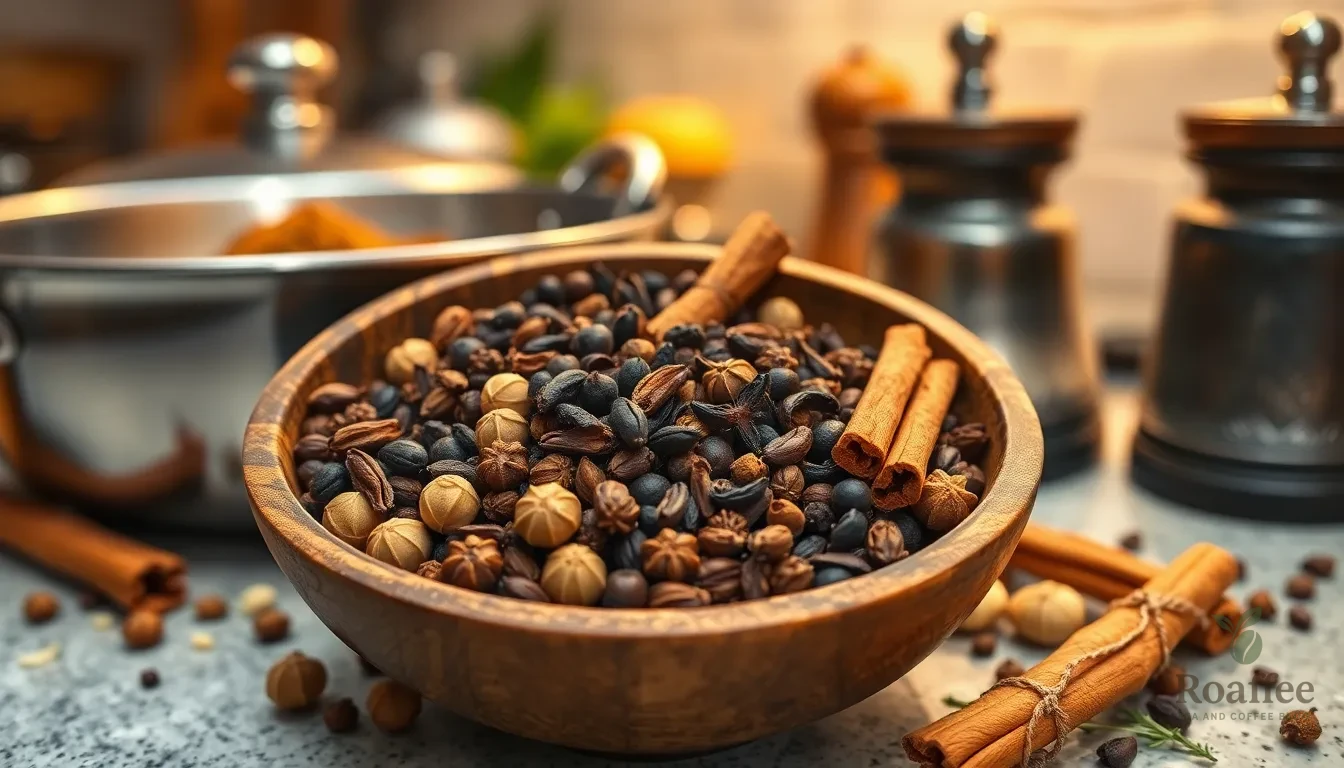
Creating our homemade tea masala powder involves a careful process of preparing and roasting whole spices to unlock their aromatic oils. We’ll guide you through each step to ensure your masala blend delivers the perfect balance of warmth and flavor.
Prep the Spices
We begin by measuring out all our whole spices according to our recipe proportions. Clean each spice thoroughly and remove any debris or damaged pieces. Break larger spices like cinnamon sticks and nutmeg into smaller pieces to ensure even roasting and easier grinding. This preparation step helps our spices roast uniformly and prevents any bitter flavors from developing.
Dry Roast the Spices
We start by heating our heavy-bottomed pan over low flame without any oil. Add the cardamom pods, cloves, black peppercorns, cinnamon pieces, and fennel seeds to the pan first. Roast these spices for 1-2 minutes until they become aromatic and release their natural oils. Set these roasted spices aside to cool completely.
Next, we dry roast the dry ginger pieces separately in the same pan until they become fragrant. Finally, add the tulsi seeds and nutmeg pieces, roasting them gently until aromatic. This separate roasting technique ensures each spice reaches its optimal flavor point without burning.
Cool and Grind
We allow all our roasted spices to cool completely before grinding, as hot spices can create moisture in our grinder. Transfer all the cooled spices to our spice grinder or blender. Grind the mixture to a slightly coarse powder texture rather than a fine powder. This coarser consistency prevents the masala from making our tea gritty while still allowing the spices to release their flavors effectively when steeped in hot water.
Strain and Store
We can use our freshly ground masala powder immediately or store it for later use. Transfer the powder to an airtight container and keep it away from direct sunlight and moisture. Our homemade chai masala powder maintains its peak potency and flavor for up to one month when stored properly. Label the container with the preparation date to track freshness and ensure we use it while the aromatic oils are at their strongest.
Storage Instructions
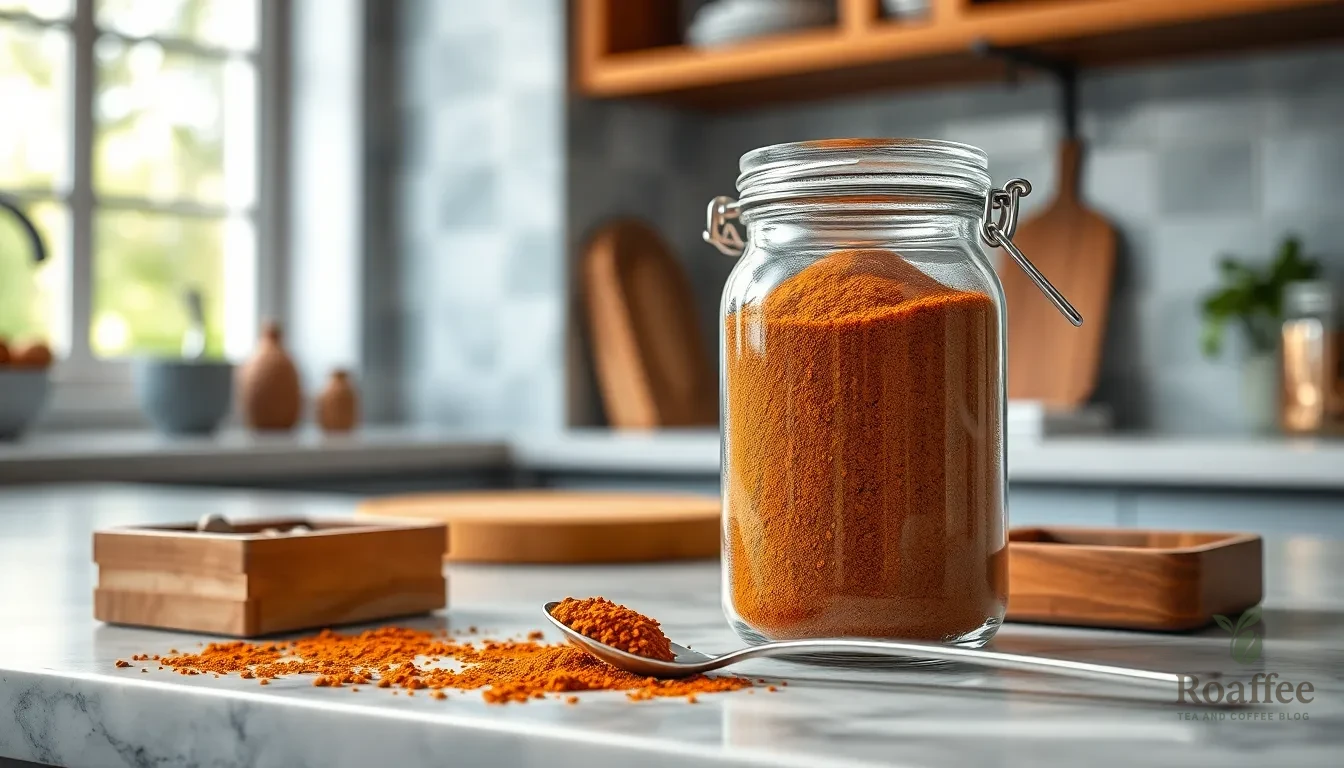
We recommend storing our homemade tea masala powder in a tightly sealed airtight jar to maintain its potency and aromatic qualities. The container should be kept in a cool dry place away from direct sunlight to prevent the spices from losing their essential oils.
Our masala powder remains most potent for about 1 month when stored properly. The flavor quality stays good for up to 3 months under optimal storage conditions. For extended preservation we can store the masala in the freezer which helps retain freshness and aroma for up to a year although flavor may gradually decline over time.
| Storage Method | Duration | Quality |
|---|---|---|
| Room temperature (airtight) | 1 month | Most potent |
| Room temperature (airtight) | Up to 3 months | Good flavor |
| Freezer storage | Up to 1 year | Gradually declining flavor |
Always use a dry spoon when adding masala to prevent moisture contamination. Moisture can cause the powder to clump and reduce its shelf life significantly. We find that keeping the storage container away from the stove and other heat sources helps maintain the spice blend’s integrity.
The homemade approach allows us to control the freshness factor unlike store bought versions that may have been sitting on shelves for extended periods. Our carefully crafted blend retains its aromatic properties when we follow these storage guidelines ensuring every cup of chai delivers the authentic flavor we created.
Usage Tips
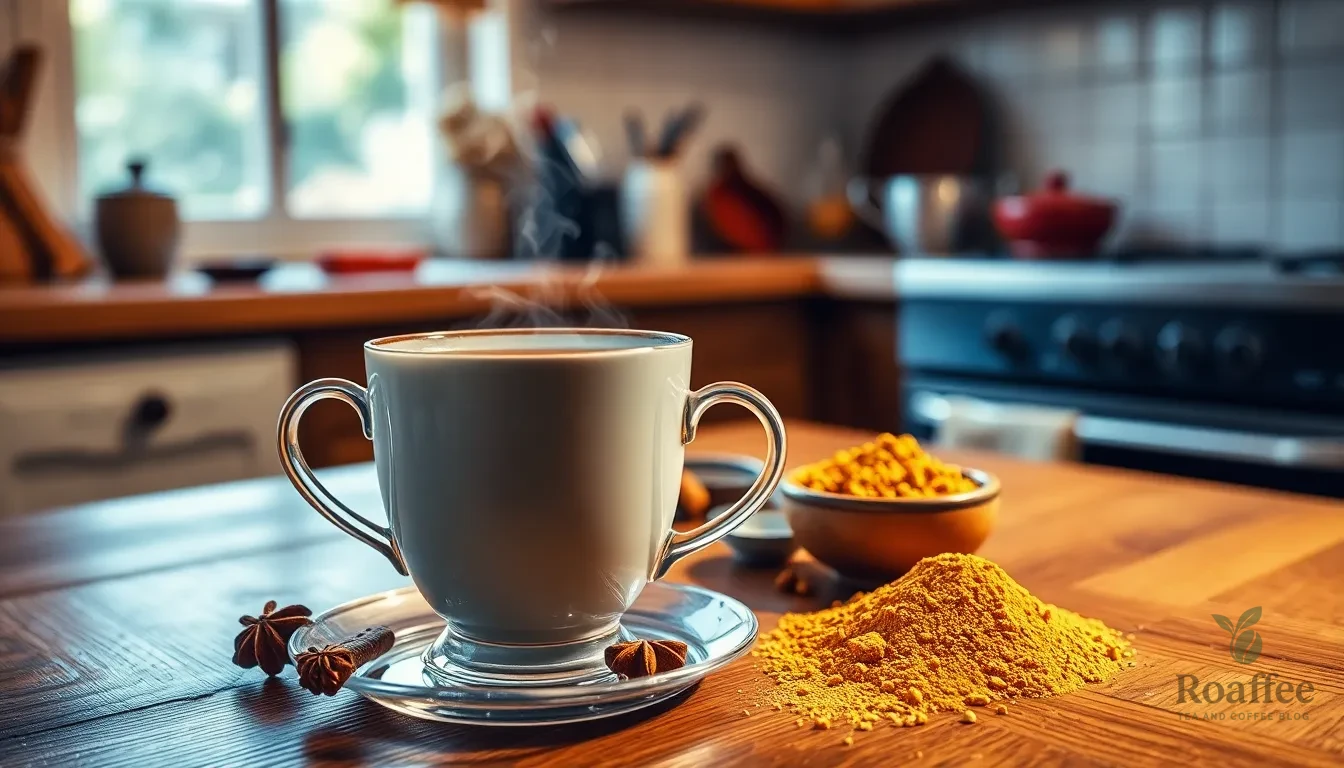
Getting the perfect cup of chai requires knowing how much masala powder to use and the best brewing techniques. We’ll share our proven methods for achieving that ideal balance of spice and flavor.
How Much to Use
We recommend starting with ½ teaspoon of chai masala powder per 2 cups of water for the perfect spice balance. This measurement creates a robust flavor without overwhelming the tea’s natural taste.
For single servings, use approximately ¼ teaspoon chai masala per 1 cup of water. We’ve found this ratio works exceptionally well for most palates, though you can adjust according to your spice preferences.
| Serving Size | Water | Chai Masala Powder |
|---|---|---|
| Single cup | 1 cup | ¼ teaspoon |
| Double serving | 2 cups | ½ teaspoon |
| Family batch | 4 cups | 1 teaspoon |
Remember that a little masala goes a long way in flavoring your tea. We always suggest starting with less and adding more if needed, as you can’t remove excess spice once it’s added.
Best Brewing Methods
We begin by boiling water with tea leaves and chai masala powder together. Use approximately 4 teaspoons of tea leaves for 2 cups of water along with your measured masala powder for optimal strength.
Boil this mixture for 3 to 4 minutes to create a strong decoction. This timing allows the spices to release their essential oils and blend harmoniously with the tea leaves.
Add 1 cup of milk per 2 cups of water along with 2 teaspoons of sugar or adjust to taste. We find this milk-to-water ratio creates the perfect creamy texture without diluting the spice flavors.
Boil the mixture again briefly, then reduce heat and simmer until you achieve your desired flavor intensity and thickness. The simmering process allows all ingredients to meld together beautifully.
Strain the chai through a fine sieve to remove spice bits and tea leaves. Using our coarsely ground powder makes this straining process much easier and more effective.
Serve immediately while hot for the best flavor experience. We recommend adjusting spice quantities based on your family’s preferences, as some people prefer stronger ginger or cardamom notes in their chai.
Variations
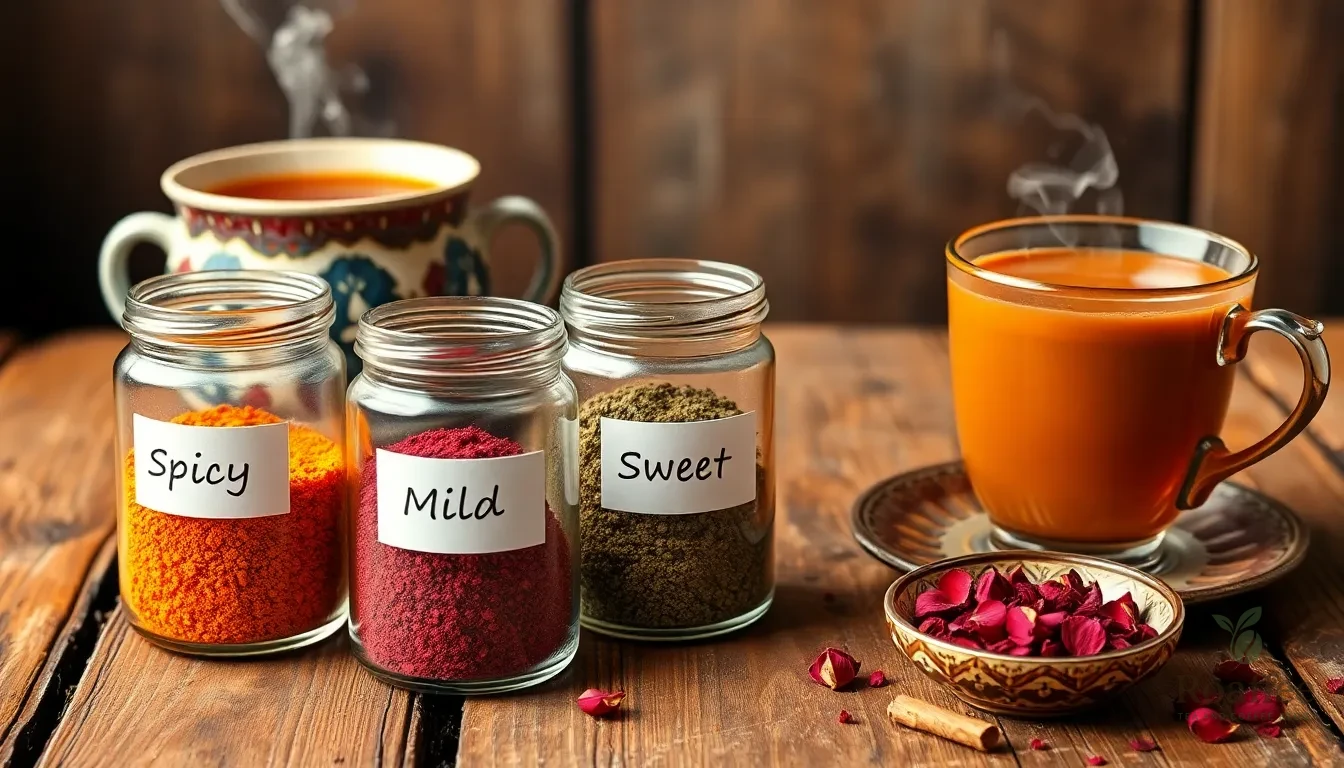
Our basic tea masala powder recipe provides the perfect foundation for creating customized spice blends that suit different taste preferences. We can easily adjust the spice ratios to create unique flavor profiles that enhance your chai experience.
Spicy Tea Masala
We increase the heat and pungency in this variation to create a warming blend that delivers a stronger kick. Our spicy version emphasizes black pepper and dry ginger while adding extra cloves or black peppercorns for intensified warmth.
Key adjustments for spicy masala:
- Double the black pepper quantity from 20g to 40g
- Increase dry ginger from 30g to 45g
- Add 5-10 additional cloves for deeper warmth
- Include 2-3 extra black peppercorns for enhanced heat
This robust blend works perfectly during cold weather or when you need an energizing boost. We recommend starting with ¼ teaspoon per cup and adjusting based on your heat tolerance.
Mild Tea Masala
We create a gentle and soothing blend by reducing the intensity of warming spices while emphasizing sweeter, more aromatic elements. Our mild version balances the spices to provide comfort without overwhelming heat.
Key adjustments for mild masala:
- Reduce black pepper from 20g to 10g
- Decrease cloves from 20g to 12g
- Increase fennel seeds from 10g to 18g for natural sweetness
- Add extra cardamom from 40g to 50g for aromatic balance
This version creates a comforting tea that appeals to those who prefer subtle spice notes. We find it particularly suitable for evening chai or when serving guests with sensitive palates.
Sweet Tea Masala
We enhance the natural sweetness and aromatic qualities in this variation by incorporating ingredients that complement sugar or sweeteners. Our sweet version creates a naturally fragrant blend that pairs beautifully with milk and sugar.
Key adjustments for sweet masala:
- Add dried rose petals (5g) for floral sweetness
- Increase fennel seeds from 10g to 20g for enhanced sweetness
- Add extra cinnamon from 8g to 15g for warming sweetness
- Include additional nutmeg for aromatic depth
This aromatic blend reduces the need for excessive sugar while creating a naturally sweet and fragrant chai. We recommend this variation for afternoon tea or when you want to create a luxurious chai experience.
| Variation Type | Heat Level | Sweetness | Best For |
|---|---|---|---|
| Spicy Tea Masala | High | Low | Cold weather, morning energy |
| Mild Tea Masala | Low | Medium | Evening tea, sensitive palates |
| Sweet Tea Masala | Medium | High | Afternoon tea, luxury experience |
Troubleshooting Tips
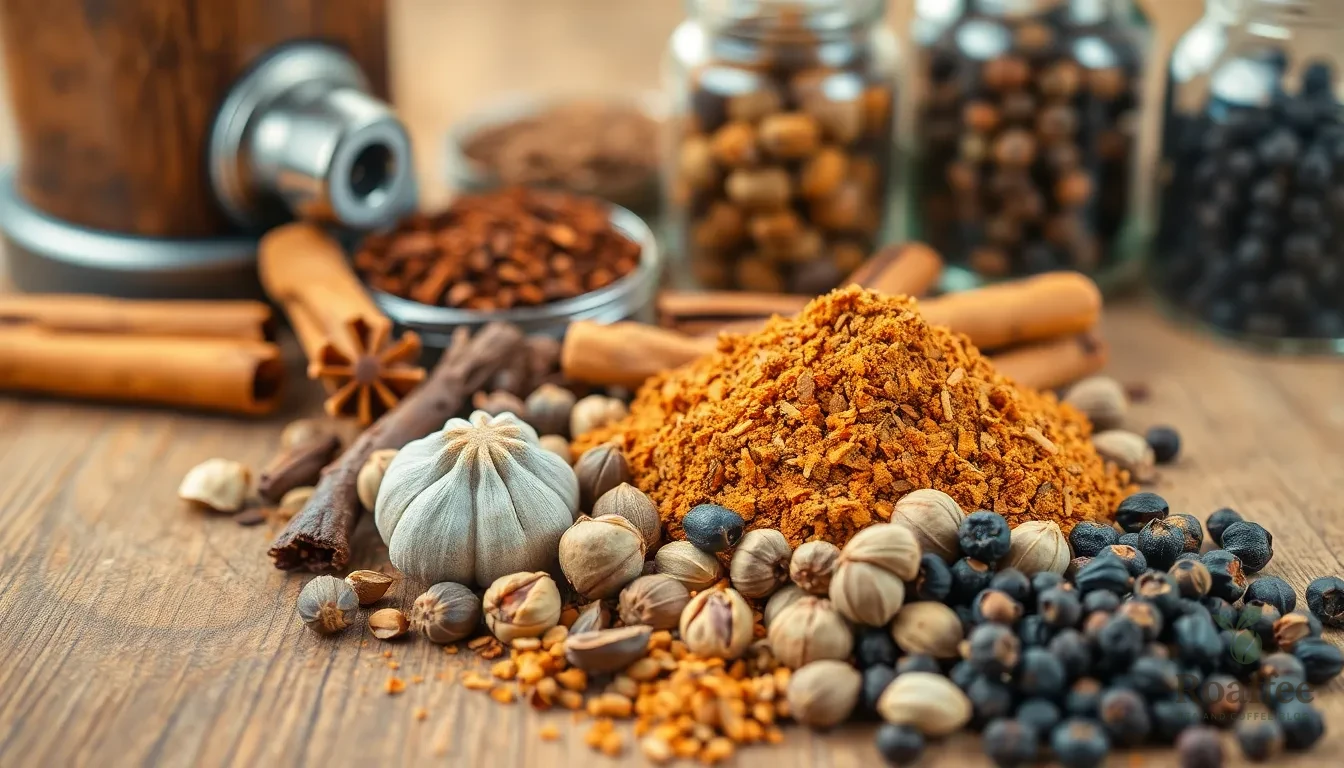
Even experienced home cooks encounter challenges when making tea masala powder. We’ve compiled answers to common problems that might arise during the spice grinding process.
Powder Turns Too Fine and Dusty
When your spice grinder produces powder that’s too fine, it creates a dusty texture that makes tea gritty. Stop grinding immediately and pulse the grinder in short bursts instead of running it continuously. Allow the spices to cool completely before grinding, as warm spices tend to create more dust. Clean your grinder thoroughly between uses to prevent residue buildup that contributes to over-grinding.
Spices Burn During Roasting
Burnt spices release bitter compounds that ruin the entire batch. Reduce heat to the lowest setting and roast each spice separately for better control. Watch for color changes rather than relying solely on timing, as pan thickness affects heat distribution. Remove spices immediately when they release their aroma and show slight color deepening.
Uneven Grinding Results
Large pieces mixed with fine powder indicate inconsistent grinding. Break larger spices like cinnamon sticks into smaller pieces before grinding. Process similar-sized spices together rather than mixing different textures. Shake the grinder container between pulses to redistribute spices for uniform grinding.
Masala Powder Loses Potency Quickly
Rapid flavor loss typically results from improper storage or moisture exposure. Ensure spices are completely cooled before storing to prevent condensation. Store the powder in a dark location away from kitchen heat sources. Use glass containers instead of plastic, as plastic can absorb and retain odors that affect spice quality.
Bitter or Harsh Flavor
Excessive roasting or incorrect spice ratios create unpleasant bitterness. Taste individual spices after roasting to identify over-roasted components. Reduce quantities of stronger spices like cloves and black pepper in your next batch. Balance harsh flavors by adding more sweet spices like cardamom or cinnamon.
Powder Clumps During Storage
Moisture absorption causes clumping that makes measuring difficult. Add a few grains of uncooked rice to your storage container to absorb excess moisture. Ensure your storage spoon is completely dry before use. Store containers in low-humidity areas away from the stove and dishwasher steam.
Conclusion
Creating your own tea masala powder transforms every cup of chai into a personalized aromatic experience. We’ve shown you how simple ingredients and proper techniques can produce a blend that’s far superior to store-bought alternatives.
The beauty of homemade masala lies in its flexibility – you can adjust spices to match your taste preferences and dietary needs. Whether you prefer our classic recipe or one of the variations we’ve shared each blend offers authentic flavors that commercial powders simply can’t match.
With proper storage your homemade tea masala powder will keep your kitchen stocked with ready-to-use authentic chai flavoring. We encourage you to experiment with different spice ratios until you discover your perfect blend. Your taste buds will thank you for choosing fresh homemade quality over processed alternatives.
Frequently Asked Questions
What is homemade tea masala powder?
Homemade tea masala powder is a blend of traditional Indian spices including cardamom, cinnamon, cloves, ginger, and other aromatic spices that enhance the flavor of chai. Unlike store-bought versions, it’s free from artificial flavors and preservatives, allowing you to control the freshness and intensity of your spice blend for an authentic chai experience.
What spices are included in tea masala powder?
The essential spices include green cardamom pods, black peppercorns, cloves, cinnamon sticks, fennel seeds, cumin seeds, nutmeg, dried ginger pieces, star anise, and bay leaf. Optional ground spices like ginger powder, black pepper, and nutmeg can also be added to create the perfect aromatic blend.
What equipment do I need to make tea masala powder?
You’ll need a heavy-bottomed pan or skillet for dry roasting spices, a spice grinder or blender for grinding, and an airtight container for storage. A mortar and pestle is optional but helpful for crushing whole spices before grinding. The right equipment ensures you achieve an exceptional aromatic blend.
How do I make homemade tea masala powder?
Start by measuring and cleaning your spices, then break larger ones into smaller pieces. Dry roast each spice separately in a heavy-bottomed pan to unlock aromatic oils. Let them cool completely, then grind to a slightly coarse powder. Store in an airtight container away from sunlight and moisture.
How should I store tea masala powder?
Store in a tightly sealed airtight jar in a cool, dry place away from direct sunlight. The masala powder remains most potent for about one month, with good flavor lasting up to three months. For extended preservation, freeze the masala for up to a year, though flavor may gradually decline.
How much tea masala powder should I use per cup?
Start with ½ teaspoon of chai masala powder per 2 cups of water for balanced flavor. Boil water with tea leaves and chai masala powder together for optimal strength. Add milk and sugar, simmer the mixture, then strain for a smooth finish. Adjust quantities based on personal preferences.
What are the different variations of tea masala powder?
Three main variations include Spicy Tea Masala (more black pepper and dry ginger for heat), Mild Tea Masala (reduced intensity for a soothing blend), and Sweet Tea Masala (enhanced sweetness with dried rose petals and extra cinnamon). Each variation caters to different taste preferences and occasions.
What common problems occur when making tea masala powder?
Common issues include producing powder that’s too fine and dusty, burning spices during roasting, uneven grinding results, rapid loss of potency, bitter or harsh flavors, and clumping during storage. These problems can be avoided through proper roasting techniques, correct grinding methods, and appropriate storage conditions.

